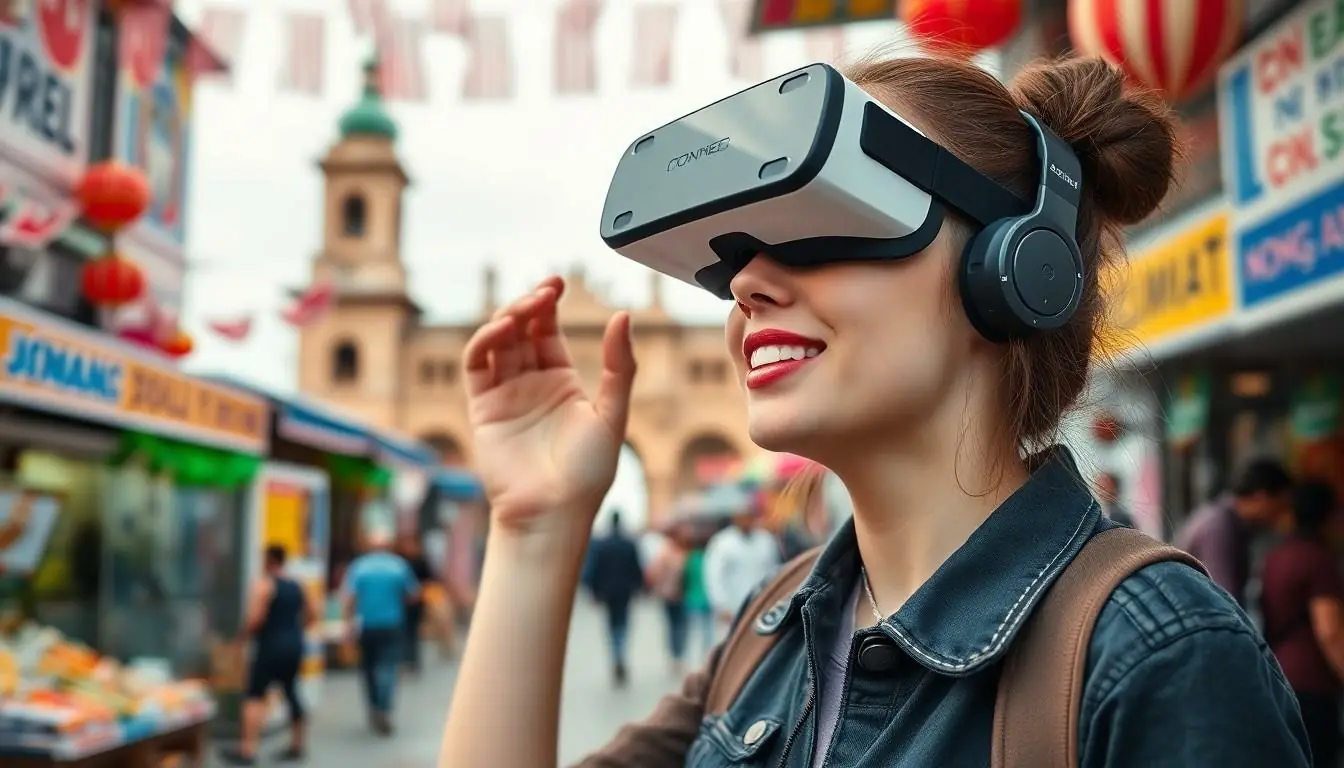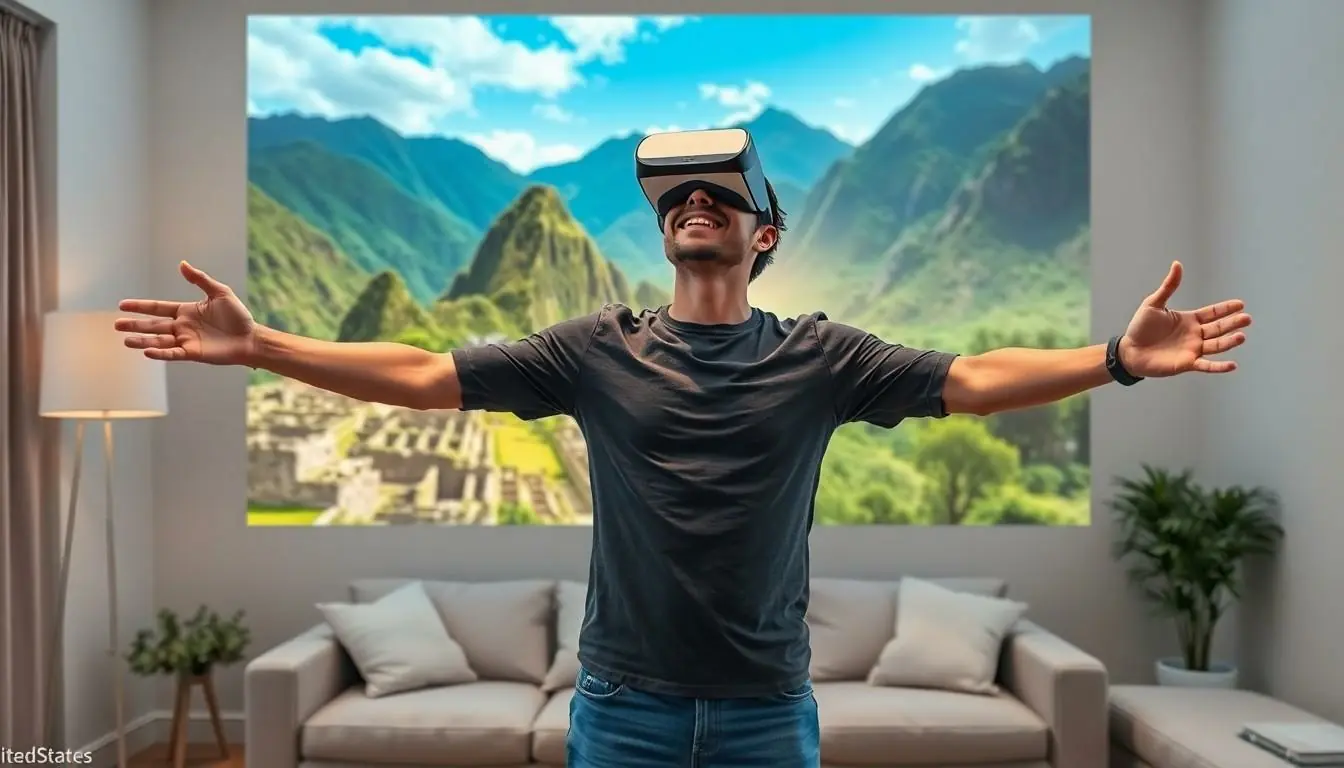Imagine exploring the ancient ruins of Rome without the hassle of jet lag or airport security. Virtual reality travel makes this dream a reality, whisking adventurers away to breathtaking destinations from the comfort of their couch. Gone are the days of overpriced plane tickets and packing nightmares. With just a headset, anyone can embark on a whirlwind tour of the world’s wonders.
Table of Contents
ToggleWhat Is Virtual Reality Travel?
Virtual reality travel refers to the use of technology to immerse individuals in realistic simulations of destinations around the world. Users can explore stunning locations, including ancient ruins, vibrant cities, and natural wonders, all from the comfort of their homes. With a virtual reality headset, the experience becomes interactive, providing a sense of presence that traditional media can’t offer.
Experiences may simulate everything from walking through the streets of Paris to standing at the foot of the Great Wall of China. Additionally, this technology reduces the physical demands associated with travel, such as long flights and navigating unfamiliar environments. Special software and applications enable users to access a variety of landscapes, cultures, and historical sites within seconds.
Customization options enable individuals to tailor their experiences based on interests. Some platforms focus on educational journeys, showcasing historical events and significant landmarks. Others prioritize adventure, allowing users to undertake activities like scuba diving or mountain climbing in virtual environments.
Accessibility plays a critical role in the appeal of virtual reality travel. Unlike traditional travel, which often involves logistical barriers, virtual tours offer an affordable alternative. This method caters to diverse audiences, including those with mobility challenges or financial constraints. Virtual reality travel provides an inclusive approach to experiencing the globe, encouraging people to explore places they may never physically visit.
Technological advancements are driving the growth of virtual reality travel, with improved graphics and interactivity enhancing the user experience. As this technology evolves, it holds the potential to redefine how individuals approach travel, making global exploration more engaging and accessible than ever before.
Benefits of Virtual Reality Travel

Virtual reality travel offers numerous advantages, enhancing the way people explore destinations. Its foremost benefit is the immersive experience provided by cutting-edge technology.
Immersive Experiences
Immersive experiences in virtual reality travel allow users to engage with environments like never before. From scaling the heights of famous landmarks to wandering through bustling markets, the level of engagement keeps users captivated. Participants feel as if they are truly present, as visuals and sounds recreate authentic atmospheres. Interactivity adds another layer, allowing users to choose their paths or access information about the surroundings. Rather than viewing a static image or video, individuals enter a dynamic space that adapts to their movements, making each exploration unique. Realistic simulations of cultures and environments deepen appreciation for global diversity.
Accessibility and Convenience
Accessibility and convenience represent key benefits of virtual reality travel. Users can experience the world from their homes, eliminating travel challenges such as jet lag or crowded airports. Financial savings also play a significant role, as virtual exploration often costs considerably less than traditional trips. Individuals with mobility limitations or health concerns benefit greatly, as they can enjoy immersive travel without physical barriers. In addition, customization options cater to educational content or adventure themes, appealing to various interests. This easy access to diverse experiences promotes inclusivity, encouraging more people to engage with global cultures.
Popular Virtual Reality Travel Platforms
Multiple platforms provide virtual reality travel, allowing users to explore diverse locations and cultures from their homes. Each platform offers unique features and experiences.
Overview of Leading Platforms
Top platforms include Oculus, Viveport, and SteamVR. Oculus provides an extensive library of immersive experiences, including scenic destinations and interactive tours. Viveport emphasizes a subscription model, granting access to various virtual travel content. SteamVR hosts a wide array of user-generated experiences, allowing customization and exploration of countless environments. Additionally, platforms like Wander and National Geographic Explore offer specialized virtual travel experiences that highlight specific cultural heritage and natural attractions.
Notable Experiences Offered
The experiences available on these platforms range from walking through famous landmarks to participating in guided tours. Users can stand atop the Eiffel Tower or explore the Great Wall of China with interactive elements. National Geographic Explore presents breathtaking documentaries and educational content, immersing users in wildlife encounters. The platform Wander allows users to visit nearly any location on Earth through satellite imagery and 3D reconstructions. Each experience encourages a deeper understanding of the world and its diverse cultures.
Challenges and Limitations
Virtual reality travel faces several challenges and limitations that can hinder its full potential.
Technology Barriers
Limited access to advanced technology creates significant hurdles for users. Many individuals lack high-quality virtual reality headsets, which affects overall experience quality. Software compatibility issues arise across various platforms, complicating user engagement. Connection speed impacts streaming and may disrupt immersive experiences, leading to frustration. Additionally, high costs associated with necessary hardware and software may deter potential users, reducing wide adoption.
User Experience Concerns
User comfort remains a priority in virtual reality travel. Some individuals experience motion sickness during simulations, which affects their enjoyment. The learning curve associated with navigating these platforms can frustrate inexperienced users. Interaction designs often lack intuitiveness, complicating exploration for various demographics. Accessibility features are essential to accommodate users with disabilities, yet many platforms fall short. Content variety is vital to maintaining user interest, though repetitive experiences can lead to disengagement.
The Future of Virtual Reality Travel
The future of virtual reality travel promises to revolutionize how individuals explore the world. Innovations in technology lead to enhanced graphics, creating lifelike environments that further immerse users. Developers focus on improving accessibility, ensuring everyone can enjoy virtual adventures regardless of physical limitations.
Platforms evolve, offering diverse experiences that cater to all interests. Oculus, for example, continually expands its library, while Viveport’s subscription model provides a cost-effective way to access various content. Greater customization options enable users to tailor their journeys, making interactions more meaningful.
Challenges persist despite advancements. Technology barriers remain a concern, especially for those without access to high-end headsets. Costs associated with essential hardware deter potential users, limiting audience reach. Motion sickness and user experience issues can frustrate individuals attempting to navigate these immersive worlds.
Increased collaboration between tech companies and content creators fosters a larger pool of engaging content. Continual investment in development also leads to improved user interfaces, enhancing navigation. Diverse content remains essential to maintaining interest and encouraging exploration.
Rising interest in virtual reality travel presents opportunities for education and cultural exchange. Users can participate in guided tours or visit historical sites while learning about global diversity. The convenience of experiencing these adventures from home opens doors for countless individuals.
As technology progresses, virtual reality travel may become mainstream, altering how individuals perceive and engage with global exploration. Prioritizing immersive quality alongside accessibility enhances the overall experience for every user. Expect to see this transformative evolution come to fruition as the industry grows and evolves.
Virtual reality travel is transforming the way individuals experience the world. It offers a unique opportunity to explore diverse cultures and breathtaking locations without the typical challenges of traditional travel. As technology advances, the immersive quality of these experiences is set to improve, making them even more engaging and accessible.
The potential for education and cultural exchange through virtual reality travel is immense. With platforms continually evolving to meet user needs, the future looks bright for those seeking adventure from the comfort of their homes. Embracing this innovative approach could redefine global exploration for everyone, regardless of physical limitations or financial constraints.

